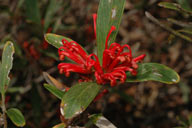In Flower This Week
A weekly news sheet prepared by a Gardens' volunteer.
Numbers before each plant refer to temporary IFTW labels in the gardens.
Numbers in square brackets [ ] refer to garden bed Sections. Plants in flower are in bold type.
View past issues of 'In Flower This Week'.
6 September 2013
Grevillea dimorpha click for larger image |
A walk along the curvaceous Main Path this time of the year is a pleasant experience. Flowers are plentiful, including many grevilleas and wattles. The walk commences at the far end of the café building.
- A wattle, Acacia alata var. biglandulosa [Section 240], is attractive with its cream flower balls attached to the odd zig-zag stems of the dense medium shrub.
- An emu bush, Eremophila drummondii [Section 302], is an upright many-branched shrub bearing many tiny mauve bugle‑shaped flowers.
- Continue along this path where Acacia baileyana [Section 30] is a dense prostrate shrub clad with buds and many golden flower balls... the perfume of wattles permeates the gardens.
- Beside this is Banksia ericifolia [Section 30], a large spreading shrub bright with upright cylindrical golden flower spikes.
- Opposite is Homoranthus flavescens [Section 30], a shrub with lateral branches which appear to be layered. Its perfumed yellow flowers are in erect clusters.
- Grevillea ‘Flame n’ Beauty’ [Section 25] is a shrub of medium size bearing attractive lemon flowers with red styles.
- Close by is Grevillea dimorpha [Section 25], with long upright branches and red flowers.
- Across the next road Grevillea ‘LadyO’ [Section 26] displays its own shade of red flowers edging the long arching branches. (She really is a beauty.)
- Nearby is Hakea ‘Winter Burgundy’ [Section 26], a taller shrub with flowers crowded about the terminal branches.
- Grevillea lavandulacea [Section 26] differs with grey-green foliage brightened with deep red flowers.
- Behind is Grevillea sericea [Section 26], a taller shrub with pink spider-like flowers.
- Further on Grevillea vestita subsp. isopogoides [Section 26] is clad with cream fluffy flowers over the low spreading plant.
- Across the road Phebalium whitei [Section 112] is a slim upright plant bearing terminal yellow flowers.
- Boronia muelleri [Section 112] is a dense shrub laden with pink buds, with some opening to pale pink star‑shaped flowers.
- The branches of Acacia buxifolia [Section 112] are clad in profusion with soft yellow flower balls.
- As elsewhere, Hardenbergia violacea [Section 112] with its purple pea-shaped flowers twines about the other plants.
- Cross the road to the Sydney Basin. A redeveloped area features Epacris purpurascens [Section 191h, 191s], with long rigid bare stems covered with rust‑coloured foliage and tipped with tiny pink flowers.
- Later, Epacris calvertiana [Section 191j] is a dense shrub with narrow tubular cream flowers scattered among the foliage. Leaving the Sydney Basin, walk through the Eucalyptus Lawn and veer up to view the developing Red Centre Garden then down through a section of wattles.
- The Rock Garden contains many flowers including Indigofera australis [Section 4], with many upright branches clad with buds in profusion and few pink pea‑shaped flowers.
- In front of the waterfall there are patches of a small white daisy, Rhodanthe anthemoides [Sections 15s, 15d, 15c]. Follow the Main Path to wander through the Rainforest Gully, a cool relaxing and pleasant place with plants displaying a variety of leaf shapes and sizes.
- Then walk down the ramp, passing Prostanthera phylicifolia [Section 210] clad with mauve flowers, to end at the Visitor Information Centre.
Barbara Daly
![Director of National Parks [logo]](../../../../images/dnp_90px.gif)







